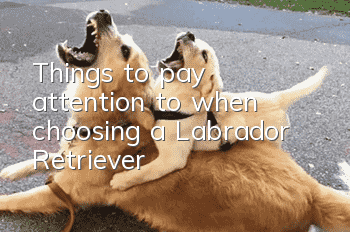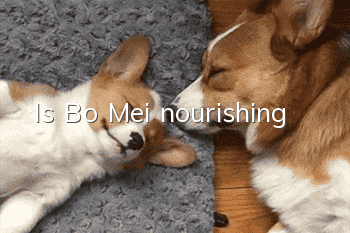Things to pay attention to when choosing a Labrador Retriever

The Labrador Retriever is a large and medium-sized dog among dogs, and has a gentle, smart and lively personality. It is the first choice for working guide dogs. So what should you pay attention to when purchasing?
1. Skull: Broad, well-developed but not too large, the occipital bone is not prominent, the facial contour is clear, showing a midline. The skull and front face are in a horizontal plane and approximately the same length. The forehead is moderate, with the forehead slightly pronounced so that the skull and nose are not on the same level. The head has a clear outline, the cheeks are not fleshy, the snout seems to be chiselled but the cheeks are prominent. The jaws are strong and strong, not scissor-shaped. A wedge-shaped head or skull that is long and narrow at the muzzle. A large and heavy back skull is undesirable.
2. Lips: Not square or droopy, but forming a curve toward the neck.
3. Mouth and nose: moderate in length and width.
4. Nose: The nose is wide and the nostrils are well developed. A black or yellow Labrador's nose should be black, while a chocolate Labrador's nose should be brown. A nose that fades to a lighter color is not considered a fault; a completely pink nose or a nose that lacks pigmentation is a disqualification.
5. Teeth: The teeth should be strong and regular, with a scissor bite, with the lower teeth touching the inside of the upper teeth. A level bite is acceptable but not ideal. "The ground covers the sky", "the sky covers the ground" or the teeth are not aligned are serious faults.
6. Ears: hanging close to the head, farther back, slightly lower than the skull, and slightly above eye level. The ears are neither large nor heavy, but in proportion to the skull and reach the eyes when pulled forward.
7. Eyes: Kind, friendly eyes convey good temperament, intelligence and alertness, which is a characteristic of Labrador. The eyes are of medium size, moderately set apart, neither protruding nor sunken inward. Black and yellow Labradors have brown eyes, while chocolate Labradors have brown or light brown eyes. Black or yellow eyes give a stern look, which is undesirable. The eye rims of black and yellow Labas shall be black, and the eye rims of Chocolate Lalas shall be brown. Eye rims without pigmentation are also disqualified. Eyes that are too small, too close or too far apart, or eyes that are noticeably round are not typical signs.
8. Neck: Appropriate length allows the dog to easily complete various activities. Labradors have well-developed neck muscles and flexible front neck. The neck rises strongly from the shoulders in a well-formed arch. A short, thick neck or an ewe-like neck is a fault.
9. Back: The back is strong. Whether standing still or during exercise, the midline of the back is always level from the humps of the shoulders to the buttocks. But the waist shows flexibility to adapt to movement
10. Torso: The torso is short, and the elastic ribs gradually taper to form a chest of suitable width. Does Labrador have breasts?There is a broad extension of the chest, like that of a Bulldog, but not so narrow that it gives the appearance of a sag between the forelegs. Standard chest conformation tapers between the forelimbs to allow adequate movement of the forelimbs. A broad chest that does not allow the dog to move efficiently and sustainably is a fault. Thick slab-like breasts are not a typical sign, as are cylindrical or barrel-shaped breasts. The midline of the lower abdomen is almost straight, but may have a slight wrinkle in adults.
11. Loin: Short and strong, extending into well-developed, powerful hindquarters. When viewed from the side, the dog shows good development without excessive forechest.
12. Tail: The Labrador’s tail is a feature that distinguishes it from other dog breeds. The Lara's tail is very thick at the base, tapering towards the tip, of medium length, and does not extend beyond the hock joints. The entire tail is covered with short and dense fur, forming a unique, otter-like rounded appearance. Whether stationary or in motion, Lala's tail always remains straight along the midline of the back, upright, but never bends over the back. A short or elongated tail is a serious fault. Any use of shortening or other methods to change the length of a pull's tail will be disqualified.
13. Shoulders: The shoulders are long and well sloped back, forming an angle of approximately 90 degrees with the forelimbs, allowing the dog to move its forelimbs firmly forward in an easy manner. The length of the shoulder blades is equal to the length of the forelegs to create a perfect structure. Any condition that prevents the dog from free movement, such as vertical shoulder blades, short forelimbs, inflexible muscles, or weight-bearing shoulders, is considered a fault.
14. Forelimbs: When viewed from the front, the limbs are vertical due to well-developed strong bones. Bones that are too thick or too thin are not typical signs. Short legs or heavy bones are also not typical signs. When viewed from the side, the elbows are just below the upper edge of the shoulder blades, so that the forelegs are at right angles to the ground. Elbows sit snugly against ribs, leaving no gaps. Elbows pointing outward or inward, interfering with the dog's movement, are serious faults.
15. Pastel: Short and strong, slightly inclined to the vertical line of the leg.
16. Hind limbs: strong and compact, with toes well arched and well-developed pads and webs. Dewclaws can be removed. Splayed or hare-footed steps, long toe joints, and steps that point in or out are serious faults. The hind legs should be perpendicular to the ground and parallel to each other, strong bones, well muscled, well defined, and well angled at the knee joints. The knee joint does not tilt when exercising or standing. When standing, the back toes are slightly behind the point of the buttocks.
17. Hind: Broad, muscular, with stifles suitable for turning and short, strong hocks.
18. Coat: Coat is an important feature of Labrador. The coat of the Lala has two layers. The surface coat is short, straight and dense, and feels rough to the touch. The undercoat is soft and can protect against water, cold and various types of thorns and other damage from the ground. Slight back painA wavy downward coat is acceptable. A woolly coat, a soft silky coat, or a smooth coat are not typical signs of pulling.
19. Color: Labrador’s coat colors include black, yellow and chocolate. Any other color or mixture of colors is non-conforming. There can be a small white spot on the chest, but it can only be limited to the chest and cannot extend to the abdomen. It is okay to have gray hair or scars due to age, but they will not be misunderstood as markings. Black Lala must be solid black; yellow can have a color range from light red to light cream; chocolate color variations can also range from light chocolate to dark chocolate.
20. Dynamic: Labrador’s movements are free and effortless. When moving, the elbows are raised almost touching the body of the dog, the limbs form a straight line and are as parallel as possible, and all parts move in the same plane. The hock joint participates in every step during movement, and is flexible and full of strength. Symptoms of faults: A short lunge or a high-knee movement indicates a straight shoulder; a wading movement indicates a long, weak pastern; a short, stepped gait indicates a straight hindquarters. department structure.
- How long does it take for a puppy to nurse after birth?
- What to do if your dog doesn’t want to cut its nails
- How to do early training for puppies
- How many months does it take to start training a dog? The best time to train a dog!
- What are pet probiotics? What should you pay attention to when using probiotics for dogs?
- What to do if your dog has tartar and bad breath
- What should you do if your dog doesn’t eat or drink? You must be vigilant!
- Is Havina smart?
- How to stop dogs from attacking people
- What should I do if my Chihuahua is anorexic and won't eat?



